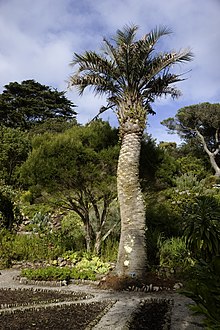Pindo palm
| Butia capitata | |
|---|---|
 |
|
| Butia capitata, Tresco, Isles of Scilly, UK | |
| Scientific classification | |
| Kingdom: | Plantae |
| (unranked): | Angiosperms |
| (unranked): | Monocots |
| (unranked): | Commelinids |
| Order: | Arecales |
| Family: | Arecaceae |
| Genus: | Butia |
| Species: | B. capitata |
| Binomial name | |
|
Butia capitata (Mart.) Becc. |
|
Butia capitata, also known as jelly palm, is a palm native to Argentina, Brazil and Uruguay. This palm grows up to 6m (exceptionally 8m) in a slow but steady manner. It is easily identifiable with feather palm pinnate leaves that arch inwards towards a thick stout trunk.
Butia capitata is notable as one of the hardiest feather palms, tolerating temperatures down to about −10 °C; it is widely cultivated in temperate climates. In the United States, Butia capitata is grown along the West Coast from San Diego to Seattle, and along the East Coast from Florida to Virginia Beach, VA, with a few known plantings north to the Long Island, NY area. Butia capitata has become naturalized in some areas of the Southern United States, from Virginia to Florida.
Ripe fruit are about the size of large cherry, and yellowish/orange in color, but can also include a blush towards the tip. The taste is a mixture of pineapple, apricot, and vanilla. Taste can vary depending on soil conditions, and the tastes of apple, pineapple, and banana together is also common. It is tart and sweet at the same time, with a flesh similar to a loquat, but slightly more fibrous.
The triterpenes cylindrin and lupeol methyl ether can be isolated from Butia capitata leaf epicuticular waxes. The pulp is a good source of β-carotene and provitamin A.
Ripe fruit of Butia capitata palm growing in Ocean Isle Beach
Butia capitata palm growing in Ocean Isle Beach, bearing both ripe and unripe fruit
Butia capitata - MHNT
...
Wikipedia
